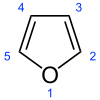| |||

| |||
| Names | |||
|---|---|---|---|
| IUPAC name
Furan
| |||
| Other names
Oxole, furfuran, furane (misspelling) [1], divinylene oxide,
1,4-epoxy-1,3-butadiene | |||
| Identifiers | |||
3D model (JSmol)
|
|||
| ChemSpider | |||
| ECHA InfoCard | 100.003.390 | ||
PubChem CID
|
|||
CompTox Dashboard (EPA)
|
|||
| |||
| Properties | |||
| C4H4O | |||
| Molar mass | 68.07 g/mol | ||
| Appearance | colorless, volatile liquid | ||
| Density | 0.936 g/mL | ||
| Melting point | -85.6 °C | ||
| Boiling point | 31.4 °C | ||
| Hazards | |||
| Flash point | -35 °C | ||
| Related compounds | |||
Except where otherwise noted, data are given for materials in their standard state (at 25 °C [77 °F], 100 kPa).
| |||
Furan is a heterocyclic organic compound, consisting of a five-membered aromatic ring with four carbon atoms and one oxygen. The class of compounds containing such rings are also referred to as furans. The parent compound is typically derived by the thermal decomposition of pentose-containing materials, cellulosic solids especially pine-wood. Furan is a colorless, flammable, highly volatile liquid with a boiling point close to room temperature. It is toxic and may be carcinogenic. Catalytic hydrogenation (see redox) of furan with a palladium catalyst gives tetrahydrofuran.


